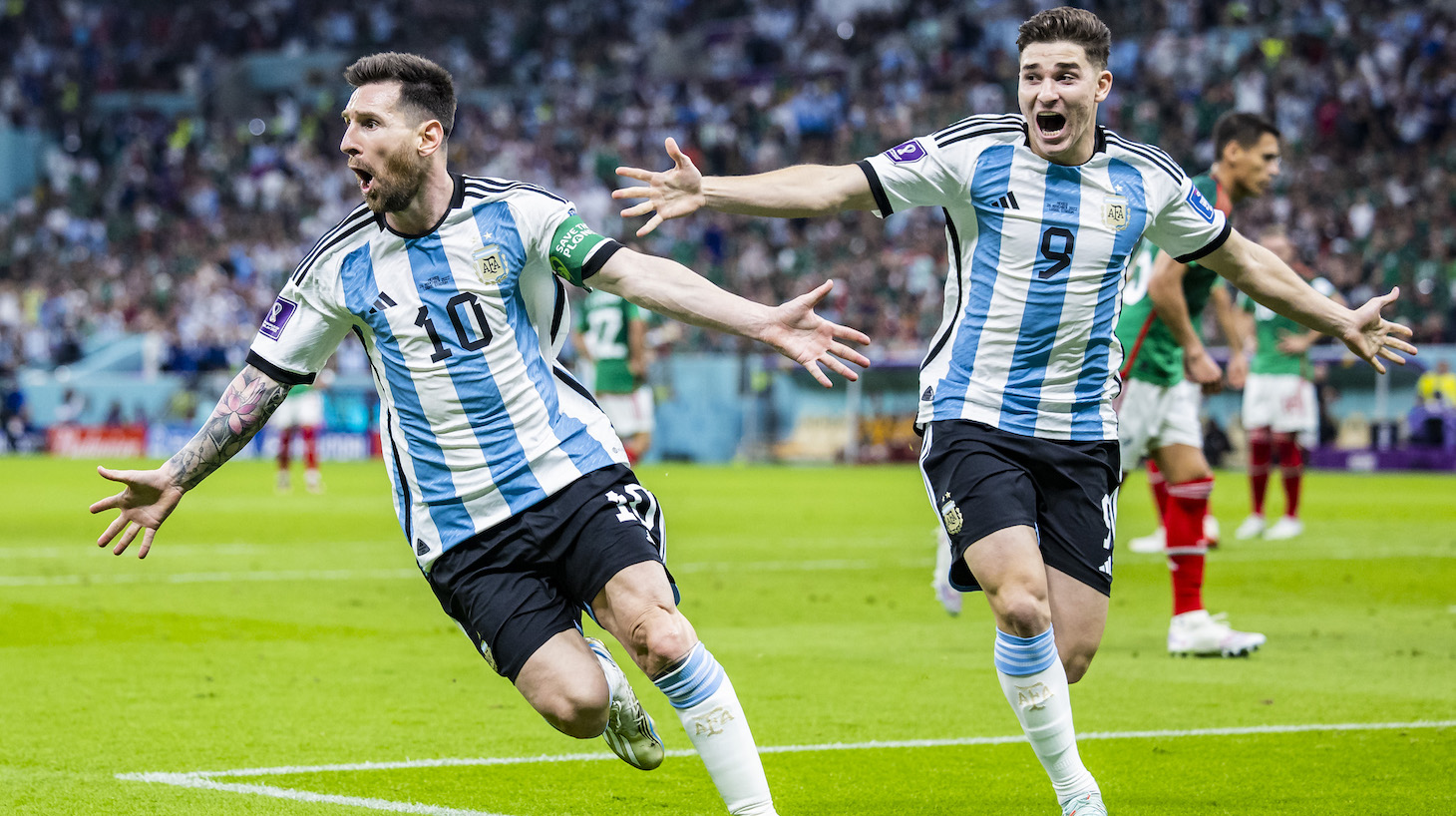Argentina entered the World Cup as one of the three big favorites to win it all. After their first match of the tournament, they were already at risk of going home.
There is an enormous difference between the Argentina team before the tournament, the one that earned those sky-high expectations with its championship pedigree and its formidable playing style and its newfound mental clarity and confidence, and the Argentina team we've seen so far in Qatar, the one that was dominated by Saudi Arabia and has spent the bulk of its World Cup in a state of anxiety and confusion. But in Saturday's must-win game against Mexico, Argentina fought through the crisis and came out victorious, which will hopefully allow the Argentina everyone expected to finally enter the competition.
Besides the result itself, the biggest thing about the Saudi Arabia match was that Argentina looked nothing like Argentina. The recent Albiceleste renaissance, which has seen the team conquer South America and along the way play the very finest soccer in the whole world over the past year, was built on a specific style of play. This style is an interior game where players with lots of technical quality and finesse unite around the ball, combine with each other in close proximity, and disassemble defenses patiently but inexorably, one dribble and give-and-go at a time—that, plus a well-ordered intermittent high press. Manager Lionel Scaloni's game model has proven an exceptional fit for this particular group of Argentines who thrive when asked to keep the ball and collaborate with it in tight spaces but aren't so physically imposing as to devour open space with long, powerful runs. The Argentina of this vintage hit its apex back in June with its masterful demolition of Italy.
From the outset of the Saudi Arabia match, it was clear that Argentina wasn't playing their usual game. Credit there goes to the Saudis, who baited their opponents into adopting a completely different playing style with the illusory promise of Saudi Arabia's extremely high defensive line. Tantalized by the prospect of endless one-on-ones with the Saudi goalkeeper, the Argentines played an extremely direct game full of launched balls over the top of the Saudi back line. Argentina fell into Saudi Arabia's (offside) trap, of its own volition denaturing itself and playing straight into the Saudis' hands. Even after taking an early lead, the Argentines never looked comfortable in how they were playing. When Saudi Arabia shocked the world with an attacking flurry in the second half, coming away with two goals and a lead they would not relinquish, Argentina panicked. Without its foundational game to fall back on, they had no way of getting back into the match.
In falling to Saudi Arabia, Argentina lost the match and also lost itself. The question going forward was how much of itself Argentina could recover, and how quickly. And a big part of this recovery would have to involve a return of the team's playing style, as the style's importance runs much deeper than just a particular way of winning games.
Throughout the Lionel Messi era, Argentina has been uniquely burdened by the weight of history and expectation. The story at this point is well-worn. Messi, the proud Argentine who left home as a teenager to pursue his dream in Spain, was looked at skeptically by many of his compatriots back home who tend to prefer those who they have seen up close. That skepticism, plus the inevitable comparisons to Argentina's most beloved star, Diego Maradona, meant Messi had to play under the very highest of demands and scrutiny, with little compassion or love to temper the sting. In the face of those ruthless expectations, Messi and the other members of his exceptional generation of Argentine players did their best to give the public what they asked for, only to come up agonizingly short three consecutive times in the form of losses in the finals of the 2014 World Cup and two Copa Américas. Each successive loss added to the psychological and emotional weight on the team, until the Argentina shirt began to look like it came with an invisible grand piano strapped on the back of it. The team eventually collapsed under the weight, started playing poorly, just barely qualified for the 2018 World Cup, and performed badly there.
But a funny thing happened in the midst of all that failure and anguish. Messi's tragic international fate humanized him in the eyes of the Argentine public. In all of Messi's many international losses, even the ugly ones, the unmistakable takeaway from each one was just how much he cares about the country and how desperate he is to make his people happy with his play. It's hard to remain cold to a guy who is often seen openly sobbing whenever Argentina gets knocked out of a tournament. Even his and his team's evident nervousness in big games was endearing in a way, since it was proof that he felt what Argentines felt and wanted more than anything—wanted so badly in fact that the yearning got in the way of actually achieving it—to eradicate the feeling and to unite star, team, and country into one by way of a trophy.
Argentina's Scaloni-era playing style has a direct effect on all of this. The Albiceleste's victory in the 2021 Copa América finally delivered Messi and the national team the triumph everyone had waited for, and that victory wouldn't have been possible without the playing style. The style gave the team structure, something it could turn to and trust to carry the team when matches are toughest and the pressure is highest. Also, by dint of corresponding to the traditional Argentine and South American ideal of play, it presented fans a style of play they could identify with, something quintessentially Argentine, in a time where the more traditionally European style of play is paradigmatic. The style and its effectiveness could calm the team's nerves, maximize the players' talents, attract the public's devotion, and, by winning Argentina the Copa, transform that invisible piano into a pair of wings.
So, yes, it was Argentina's talent that made them pre-tournament favorites in Qatar, but it was also due to the style of play and the mental freedom that the style and the Copa win had earned them. And it was both the style and the mental freedom that the Saudi Arabia loss stripped from them in one fell swoop.
The Mexico match, then, was a risk and an opportunity. The risk was that if Argentina failed to win, the team might give itself fully to the anxiety and confusion that marked the bad old days. Even a draw against Mexico, which wouldn't have necessarily ended Argentina's chances to get out of the group, likely would've signaled the end of the team's title aspirations in the tournament. But the opportunity was just as great: get a win, and the team could reset its World Cup by returning itself to itself.
From the outset of the match, it was clear that it was going to be a struggle. For my money, the first half of Argentina–Mexico was the worst-played half of the entire World Cup thus far. The atmosphere was electric, as everyone in the stadium, from the players and coaches to the fans, knew exactly how big the game was. The players on both teams took the field with energy and emotion seeping out of every pore. Unfortunately, this made for some hideous play, heavy on barging challenges and sliding tackles and thumped crosses, but very short on quality and precision and rhythm. Mexico, a team with players who like to get out and run hard and far, enjoyed the better of the early going because they knew how to take advantage of the chaos. For its part, Argentina couldn't put five passes together and sought to deal with their obvious collective nervousness with much of the same kind of direct, long ball–focused play that didn't work against Saudi Arabia.
As the match went on, though, Argentina slowly started to settle into it. The team started to try and build its attacks instead of attempting to force them into existence. With a slower pace, the team began playing more like the good Argentina, uniting players centrally and letting them cut their own path toward goal. It wasn't vintage, pre-tournament Argentina, but it was enough to get the team to be present in the match at hand instead of struggling against their own anxiety and hopes and fears. Then Argentina got the opening goal, through none other than Messi himself, and then got the victory-sealing goal off a stupendous shot from Enzo Fernández, and all was well. The relief, seen in the players' wild celebrations and even on the coaches' faces, said it all.
Aimar al borde de un ataque de nervios luego del gol de Messi.
— Carlos Altamirano (@altamirano45) November 26, 2022
Scaloni y sus lágrimas luego del gol de Fernández.
Scola alguna vez dijo una frase genial sobre lo que se siente ganar. Y no es necesariamente alegría. Es alivio.
Cuánta presión.
Emocionante. pic.twitter.com/4PNTfOVYXS
"We needed this result. We needed this euphoria," Messi said pitchside after the seismic 2–0 win. "The first half we played as we had to play, with a lot of intensity. The second half we were calmer and started to move the ball. After the goal we were ourselves again." That wasn't exactly right; even when Argentina got its goal and turned the piano back into wings, they still didn't look quite like themselves, not yet at least. But that win makes possible the full return of the best Argentina.
Argentina will still need to beat Poland in last match of the group stage to guarantee passage into the knockout rounds. Failing to make it out of the group would be a disaster. But for the first time since the kickoff of the Saudi Arabia game, it feels like we might yet see the Argentina we were promised, the one that had and still has a legitimate chance to win the World Cup. Should that Argentina, its vaunted playing style, and its hard-won confidence show up against Poland, it would be that team's first game of the tournament—the first, but certainly not its last.






